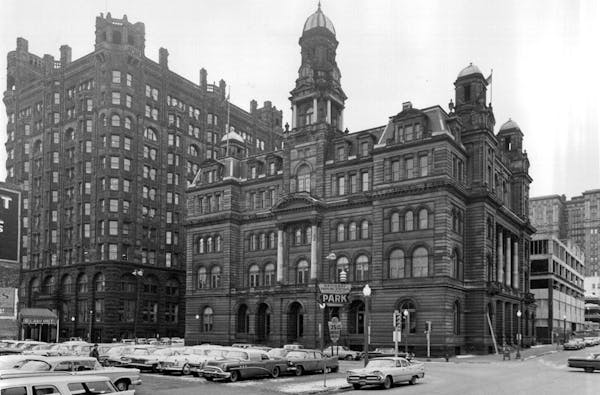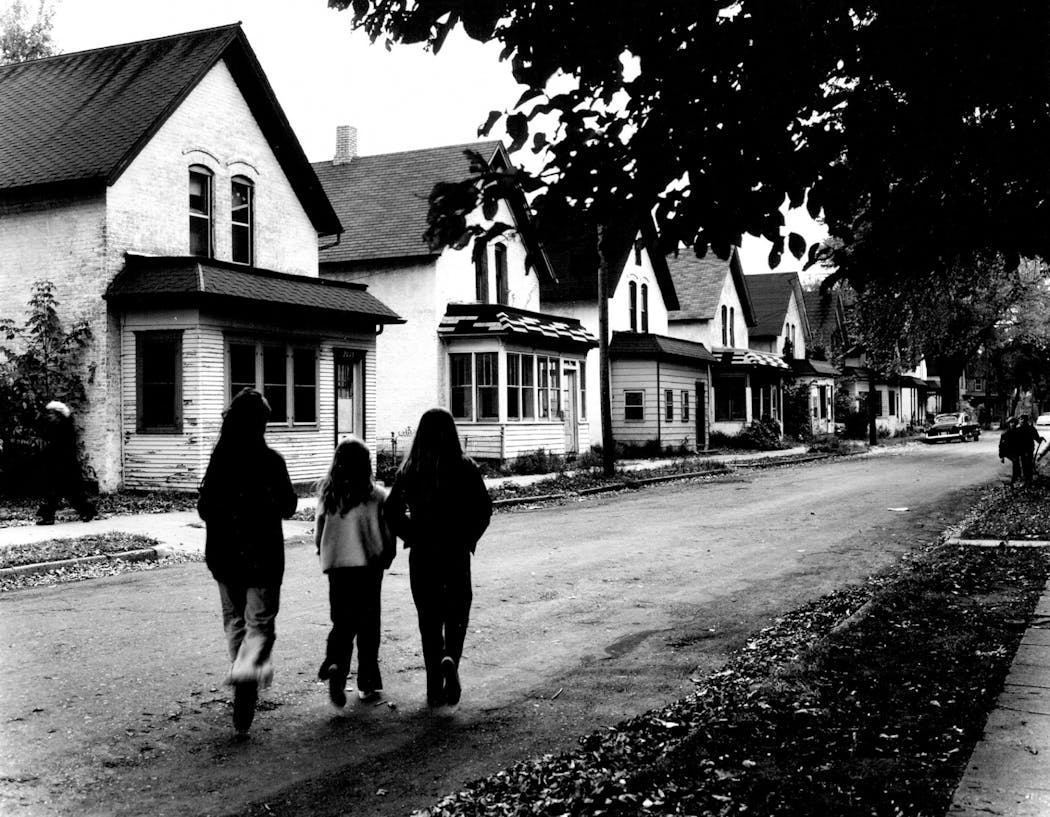In September 1970, the first of many public meetings was convened to discuss the Minneapolis Housing and Redevelopment Authority's ambitious Seward West Urban Renewal Project.
The plan involved razing 70% of the neighborhood's residential units, including all 46 houses on narrow Milwaukee Avenue, a two-block thoroughfare (it was an alley with the romantic name of 22½ Avenue) that bisects 22nd and 23rd avenues between E. Franklin Avenue and 24th Street. Its modest, tightly packed homes dated to the 1890s.
The proposal was opposed by a small but dedicated group of neighborhood activists and volunteers. They founded a grassroots nonprofit, the Seward West Project Area Committee (PAC), and dug in for a yearslong effort to preserve and revitalize the four city blocks surrounding Milwaukee Avenue.
In the end, the street was transformed into a pedestrian mall, most of its dilapidated cottage-scaled residences were rehabbed and new homes (mimicking their neighbors in scale and style) were built. The effort, billed as "renewal not removal," is one of the state's great historic preservation success stories.
Bob Roscoe was one of PAC's architectural leaders. In 2014, he published a book about the process: "Milwaukee Avenue: Community Renewal in Minneapolis."
Fifty years after that first contentious public gathering was held ("Young, old clash over Seward plan" read the headline in the next morning's Minneapolis Tribune), Roscoe strolled Milwaukee Avenue on a sunny summer afternoon and discussed gentrification, 1970s politics and the appeal of serendipity.
Q: I suppose this all starts with William Ragan, the developer who created Milwaukee Avenue in the 1880s. Was he a visionary?
A: He was in the sense that he knew he could make a lot of money. That was his mission. He plotted it out so he could put as many houses in as little space as possible. Somehow he found the plans for these workman's cottages, and he kept repeating them because he knew he could make more money that way. What was fortunate for future generations is that he used brick, and most of the houses had fancy front porches.
Q: How was the Seward West Project Area Committee structured?
A: There were always 22 members, and the group changed over time. In the end, there were probably 50 or more people involved. It was fairly grueling to be a member. It was tough duty, a big-time commitment and pretty stressful.
I got drawn in, bit by bit. Some of us didn't see anything historic about Milwaukee Avenue. I thought it had architectural significance. But it took [Seward West resident] Jeri Reilly to convince us that it had historic significance. She figured that this was an example of common man's architecture, and that was something that hadn't been given recognition before. Luckily enough, a member of the state historical society, Charles Nelson, agreed. He called it "Joe Sixpack" architecture.
Q: What role did the antiwar movement play in the PAC's approach?
A: The antiwar movement was mostly young people who were resisting the government, and because the government wanted to tear all of this down, we thought, "We're going to resist the government." According to them, this was all junk. We were always fighting with the housing authority, and from beginning to end there was a lot of infighting on the project. There was a part of the committee that took a hard line that said, "You don't do anything with the housing authority, and if you do, you're selling out."
Q: What role did my hero, Minneapolis Star columnist Barbara Flanagan, play in the project's early years?
A: When she wrote about it [in April 1972], that was a wonderful surprise. She was very enthusiastic. The housing authority thought we were a bunch of young idealists who didn't know what we were doing, but when Barbara Flanagan was interested? That gave us credibility.
Q: When Jeri Reilly's research led to Milwaukee Avenue's National Register of Historic Places designation in 1974, what effect did that have on the project?
A: It was the best thing that ever happened to us, publicity-wise.
Q: Does the word "gentrification" apply here?
A: At first, I didn't like that word, although it does apply. Yet it doesn't, because nobody here was dragged out of their house. All of the people who lived here, they wanted to move. The neighborhood was basically redlined, although no one called it that at the time. So when the housing authority offered to buy their house — the average price was around $7,500 [about $39,000 today] — there was also a $15,000 relocation benefit [about $78,000 today]. How could they pass that up?
Q: You and your wife, Sally, lived on Milwaukee Avenue. What was that like?
A: We moved here [2102 Milwaukee Av.] in 1971. It didn't have a front porch then, and it had maybe a quarter basement. Most of the houses just had a crawl space. We rented the house for about three years, but the politics got really thick, and my wife couldn't stand the politics. That's when we figured it was time we bought our own house, so we bought one in St. Paul. Then we saw an abandoned house on S. 9th Street, an old Italianate structure, and we both said, "We ought to buy that house and rehab it." And we did, and we moved the front half of it to a lot on 22nd Avenue, and that's when I re-engaged with the PAC.
Q: Looking back, is there anything, design-wise, that you would do differently?
A: I don't know I would. I guess it's lucky that it turned out the way that it did. One side of the street doesn't match the other side, but all the parts fit together. It has balance without symmetry. It's serendipity.
Q: Has Milwaukee Avenue influenced other residential historic preservation projects?
A: No, it was a one-off. My standing joke is, when this project was finished, I put my feet up on the desk and waited for the phone to ring. It didn't ring.
Basically, it never happened again because federal money was drying up. And no one else had a Tony Scallon. He was the PAC president for a long time, and if it hadn't been for Tony, we wouldn't be standing here. He had a lot of political pull, he eventually got elected to the City Council. Don Fraser had a lot to do with it, too. He was a congressman who became mayor.
Q: The project mixed rehabs with new construction, and the results are impressive. As a creative person, was it a challenge to work in the "replica" vernacular?
A: I didn't like the word "replica" then. I was more than a little skeptical. I thought that, when we tore down houses, that we'd approach the replacements in a more modern way. But the PAC said, "Nothing doing."
Q: How did Milwaukee Avenue help create the local housing rehab industry?
A: The PAC group said, "We're going to rehab these houses," and the reaction was, "What's rehab?" At the time, the rehab industry didn't really exist. The housing authority had started to realize that they were going to have to deal with us, so they were trying to connect us with various small contractors who thought that rehab was putting on a new roof, or replacing windows. Of course, it was far beyond that level. When we started, Ron Soderberg, a St. Paul contractor who had done a lot of gut rehabs, told us what to do. We had to jack the houses up, gut them and basically start over, using the house's framework.
Q: The transformation was years in the making, right?
A: That's how things always work. We started in 1970, but the first rehab didn't begin until December of '74. The rehabs started on the north end, and we worked our way down. It was considered finished in '84.
Q: Have Milwaukee Avenue property values increased over time?
A: It was surprisingly more than even the PAC people had projected. We used to call the little ones "doll houses" — that's before they got their official name, "workman's cottages" — and I think they sell for about $350,000 now. I don't think anyone has a problem selling a unit.
Q: Is there a more charming non-street in Minneapolis? I don't think so.
A: It's an intimate, compact place to live. In the planning process, everyone in the PAC agreed that we should close off the street. I was in charge of designing the walkway. It all worked out. The HOA [homeowners association] maintains the street, and the park board trims the trees.
Q: How do you like to describe Milwaukee Avenue?
A: It's an accident that it worked out. It was an accident when it was built, because William Ragan wanted to make a lot of money, so he split up these lots. And it was an accident when we were able to use the political muscle of the 1970s to resist authority. It came at the right time. If it had been a little earlier, there wasn't the mind-set for it. If it had come a little later, there wouldn't have been the money for it.
Olympian Kristi Yamaguchi is 'tickled pink' to inspire a Barbie doll

After 4 decades in music and major vocal surgery, Jon Bon Jovi is optimistic and still rocking
Rom-com author Emily Henry knows the secret to having a healthy relationship with love




